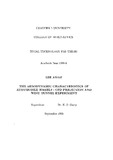JavaScript is disabled for your browser. Some features of this site may not work without it.
| dc.contributor.advisor | Garry, Kevin P. | |
| dc.contributor.author | Axon, Lee | |
| dc.date.accessioned | 2009-03-20T12:09:34Z | |
| dc.date.available | 2009-03-20T12:09:34Z | |
| dc.date.issued | 1999-09 | |
| dc.identifier.uri | http://hdl.handle.net/1826/3296 | |
| dc.description.abstract | When analyzing the aerodynamic characteristics of a road vehicle, the flow around the basic body shape is complicated by the presence of the rotating wheels. Even though on most vehicles the wheels are partially shrouded their effect on the flowfield is still considerable. Despite this, very little is understood about the flow around a rotating wheel. This thesis describes the development of a validated steady state Reynolds Averaged Navier-Stokes CFD model to investigate the flow around automobile wheels. As all the previous investigations into the aerodynamic characteristics of wheel flows had been experimental, preliminary computational studies were performed. The basis of these was the 2D circular cylinder. The effects of cylinder rotation and ground proximity were modelled, and strategies for boundary conditions and mesh topology were developed. This work was extended into 3D with the modelling of an isolated wheel, both rotating and stationary. Using existing experimental data for validation, an extensive investigation into the effects of solver numerics, symmetry planes, turbulence models, and the method of turbulent closure was performed. An optimum solver configuration was developed which comprised of the RNG k-E turbulence model with full boundary layer closure. It was accurately predicted that the rotating wheel generates less lift and drag than the equivalent stationary wheel. A number of postulated experimental flow features were captured in the final solutions. Using a parallel experimental study to provide further validation data, the CFD model was extended to incorporate an asymmetric shroud containing a wheelhouse cavity. The influence of the rotation of the wheel, the geometry of the shroud, and the thickness of the stationary groundplane boundary layer were investigated. The rotating wheel now produced more drag than the equivalent stationary wheel. Reductions in wheel drag were found with a reduction in the ride height of the shroud, and with the addition of spoilers to the lower front edge of the shroud. Increasing the stationary groundplane boundary layer thickness also reduced the wheel drag. The effects of these changes on the wheel surface pressure distributions are presented. | en_UK |
| dc.language.iso | en | en_UK |
| dc.publisher | Cranfield University | en_UK |
| dc.title | The aerodynamic characteristics of automobile wheels - CFD prediction and wind tunnel experiment | en_UK |
| dc.type | Thesis or dissertation | en_UK |
| dc.type.qualificationlevel | Doctoral | en_UK |
| dc.type.qualificationname | PhD | en_UK |
